Leptonic Decays of Heavy Vector and Pseudoscalar Mesons∗
Bin-Bin Zhou(周彬彬),Jia-Jia Sun(孙佳佳),and Yu-Jie Zhang(张玉洁),2,†
1Beijing Key Laboratory of Advanced Nuclear Energy Materials and Physics,and School of Physics,Beihang University,Beijing 100191,China
2CAS Center for Excellence in Particle Physics,Beijing 100049,China
1 Introduction
Rare decays ofD0(Bs,Bd)→l+l−forl=e,µ,orτoffer an excellent opportunity to search for new physics(NP).The leptonic decays of neutral- flavored mesons are generated through Z-penguin or W-box Feynman diagrams in the standard model(SM),so it is highly suppressed.Moreover,there is a helicity suppression factor ofin the decay widths of the leptonic decays of pseudoscalar mesonP0→l+l−,wheremlandmPdenote the masses of the lepton and scalar meson,respectively.<10−2forl=e,µ. The factor ofalso appears in the leptonic decays of charged pseudoscalar mesonP+→l+νl,but disappears in the leptonic decays of vector mesonV0→l+l−orV+→l+νl.In several NP models,the suppression factor ofP+→l+νlandP0→l+l−can be canceled,such as the minimal supersymmetric standard model(MSSM),[1−7]the two-Higgs-doublet models,[8−12]the standard model with fourth generation,[13−14]the lepton non-universality model,[15]the extra dimensional model,[16]the leptoquark model,[17−18]the next minimal supersymmetric standard model(NMSSM),[19]the dark matter,[20]and so on.[21−23]
We now take theD0andBcmesons as examples.References[22,24]gave short distance(SD)prediction:

But the dominant position ofD0→µ+µ−is the contributions from aγγ:[22,24]

The hadronic contributionD0→D∗0γ→µ+µ−is missed in previous theoretical prediction.[22,24−25]
TheBcmeson differs from other quarkoniumsb¯b,c¯cstate,because it has the two different heavy- flavor quarksbandc.Lying below theB−Dthreshold,theBcmeson can only decay via weak interactions and is stable for strong and electromagnetic interactions,thereby giving it a much longer life.[26−27]Therefore,the study ofBcmeson decay gives us a good chance to test the SM and explore NP.Two-loop QCD corrections toBcmeson leptonic decays are predicted within the SM in Ref.[28].
Pure leptonic decays ofD∗0()→l+l−andD±∗,)→lνland the hadronic contributions such asD0→D∗0γ→µ+µ−are investigated here.Some research about the excited heavy mesons are given in Refs.[25,29–33].The rest of the paper is organized as follows.In Sec.2,we provide the calculation methods of the leptonic branching fractions of the vector mesons,including charged mesons.In Sec.3,we determine the effect of the vector mesons on the pseudoscalar mesons.In Sec.4,we discuss the numerical results.Finally,we summarize the conclusions of our work.
2 The Leptonic Decay of Vector Mesons
2.1 D∗0→ µ+µ− and D0→ µ+µ−
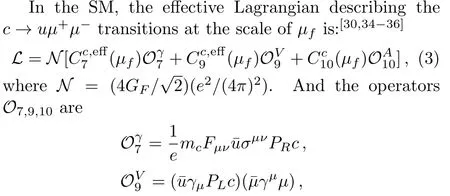
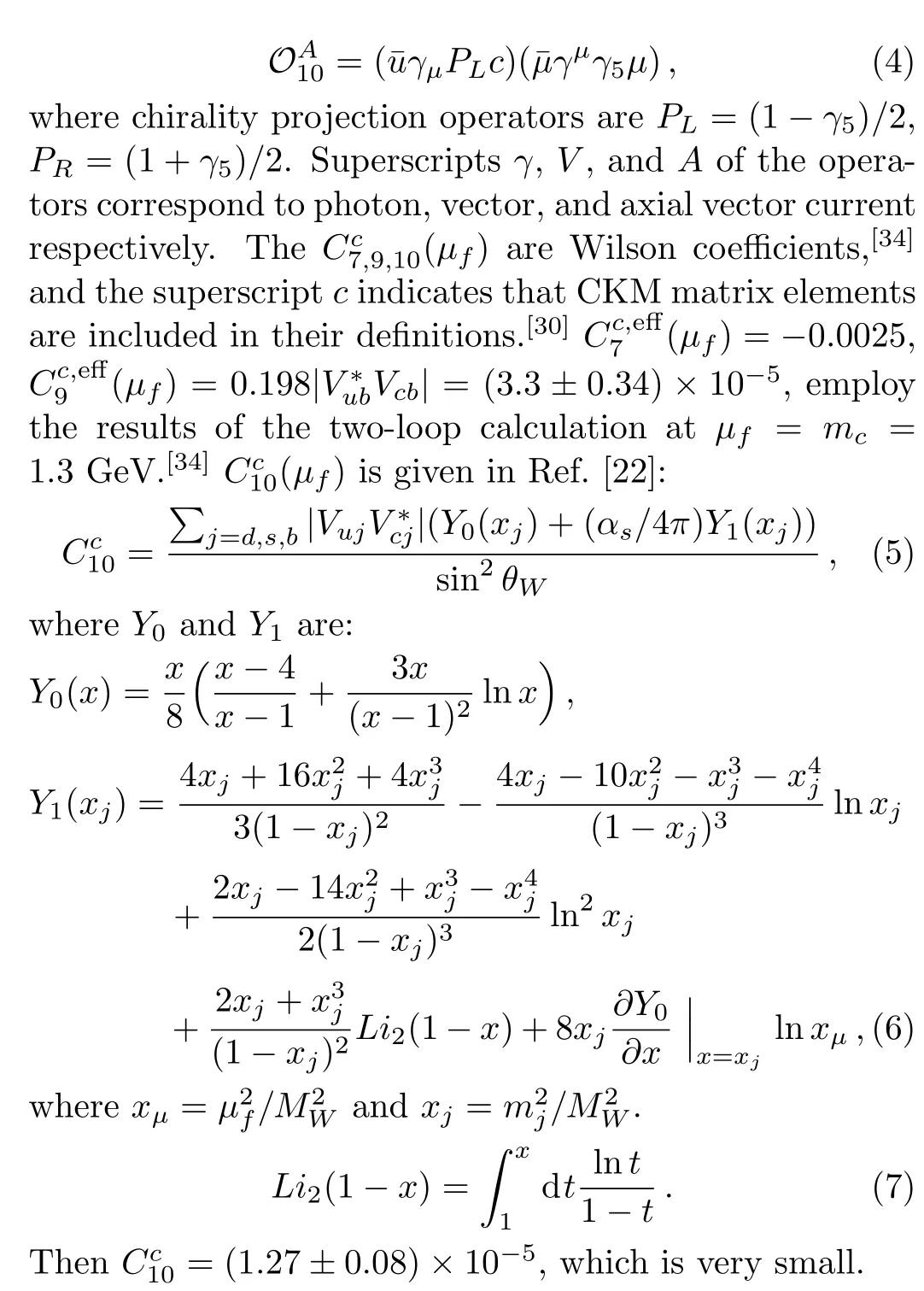
The relations between the mesons and the quark level operators are described by the following popular matrix elements:[30,37]

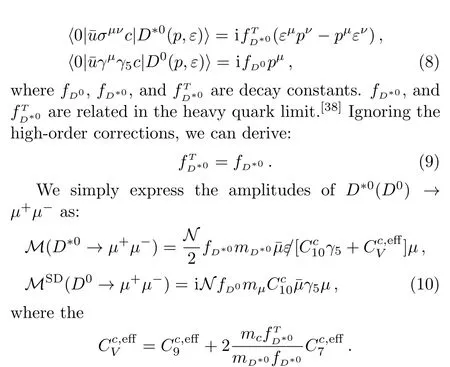
Through the dominant contributions of M(D0→µ+µ−)is the vector meson dominance(VMD)process M(D0→γ+V→γγ→µ+µ−):[24]

However,MVMD(D0→µ+µ−)is dominated by the imaginary part forV=ρ,ω,ϕ.[24]The imaginary part of M(D0→γ+D∗0→µ+µ−)disappears because the mass ofD∗0is larger than that ofD0.Hadronic contributions inD∗0→γγ→µ+µ−are an order of magnitude smaller than SD contributions and are thus ignored in this study.[30]
Then, one can calculate the decay widths ofD∗0(D0)→µ+µ−in the SM

2.2 →µ+νµand Bc→µ+νµ
The pseudoscalarBcmeson decays through a virtualW+.The W-boson couples to theBcthrough the axial vector part of the charged weak current.All QCD effects,both perturbative and nonperturbative,enter into decay rate through the decay constantfBc,defined by the matrix element:[39]

Then the decay width is

For the vector meson,the leptonic decay width can be written as

3 The Impact of Vector Mesons on the Pseudoscalar Mesons
D∗0itself generates theµlepton pair and in fluences on the leptonic decay ofD0through the process ofD0→D∗0γ→µ+µ−.Feynman diagrams ofD0→D∗0γ→µ+µ−are shown in Fig.1.And Feynman diagram ofBc→γ→µνµare shown in Fig.2.The vertex oper-ator ofD0→D∗0γcan be simplified as in Refs.[40–43].Then,we can obtain:

wheregD0D∗0γis a dimensionless coupling constant.The phase factoriin Eq.(16)is consistent with theγ∗→J/ψ+ηcamplitude of in Ref.[44].
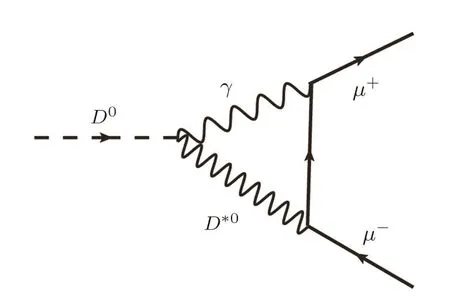
Fig.1 Feynman diagrams of D0→ D∗0γ → µ+µ−.
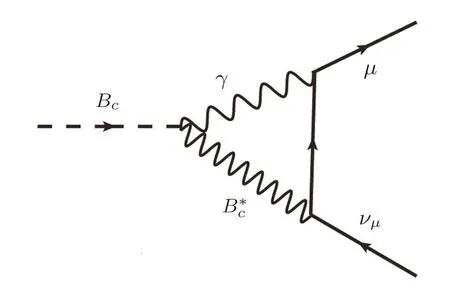
Fig.2 Feynman diagram of Bc→γ→µνµ.
The loop integrals are ultraviolet(UV)logarithmical divergent.We introduce the Pauli–Villars regularization scheme for the vector meson propogator here:

whereqVis the momentum of the vector mesons in the loop.When the vector meson is far away for its mass shell,the hadronic contribution will be suppressed,such that high energy cut Λ is approximately several ΛQCD.This scheme is same with the form factor F ofPV γvertex in Ref.[45]:

We obtain theD0→D∗0γ→µ+µ−decay amplitude

Then a factorND0is added to the amplitude ofD0→µ+µ−as:


We ignore the interference between MVMD(D0→µ+µ−)withV=ρ,ω,ϕand M(D0→γ+D∗0→µ+µ−)because MVMD(D0→µ+µ−)and M(D0→γ+D∗0→µ+µ−)are dominated by the imaginary part and real part respectively.
The dimensionless pseudo scalar-photon-vector coupling constantgD0D∗0γcan be estimated through the heavy-quark effective theories and chiral effective theories,[46−47]sum rules.[48−49]We select the radiative M1 decay widths ofD∗0→D0γto estimategD0D∗0γ:[50−51]

whereEγ=is the energy ofγin the rest frame ofD∗0.
4 Numerical Results
We list the numerical parameters appearing in formulas as follows:

The total widths and M1 transition widths are also required.Considerable research has involved the width of vector heavy mesons.[52−58]The widths ofD∗+are listed in Review of Particle Physics 2016:[59]

Then we can estimate the widths ofD∗0[30,60]as:
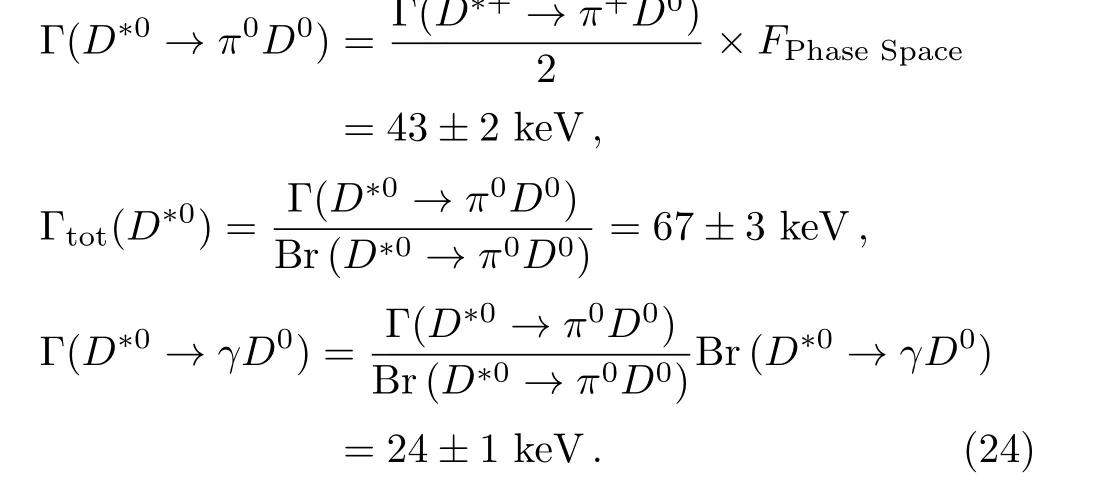
The widths ofare predicted in the following potential model:[55]

The M1 widths of,B∗+,andare predicted in Ref.[58]:

The total width and M1 width ofare predicted in the potential model in Ref.[52]as:

The decay constants ofDmesons are given in Ref.[61]:

The decay constants ofB0ormesons are given in Ref.[62]:
fB=190.5±4.2 MeV,fBs=227.7±4.5 MeV,(29)which are consistent withfB=(185±35)MeV andfBs=(224±5)MeV in Ref.[61].And the decay constants of otherBmesons are given in Ref.[61]:

The mass ofis chosen as 6.314 GeV similar to that in Ref.[63].
The branching fractions of leptonic decay of vector heavy meson are listed in Table 1.The updated prediction of branching fractions ofP0→l+l−are listed in Table 2.And the updated prediction of branching fractions ofP+→l+νlare listed in Table 3.

Table 1 The predictions of leptonic branching fractions of heavy vector mesons in SM.

Table 2 The branching fractions of P0 →l+l− measured by experimentalists[59]and predicted within the SM.

Table 3 The branching fractions of P+ →l+νlmeasured by experimentalists[59]and predicted within the SM.
5 Summary
The leptonic decays of seven kinds of heavy- flavor pseudoscalar and vector mesons,andD±(∗)are investigated.The hadronic contributions such asD0→D∗0γ→µ+µ−a
re also explored.We then obtain the updated branching fractions of the pseudo scalar mesons to lepton pairs as modified by a factor of few percentages.Specifically,the Br(B+→e+νe)is reduced by a factor 13%.Further studies on leptonic decay of these mesons in LHCb and BelleII should be conducted.
Acknowledgments
We would like to thank Profs.K.T.Chao,Y.Q.Ma,C.Meng,Q.Zhao,and S.L.Zhu for useful discussions.
References
[1]K.S.Babu and C.F.Kolda,Phys.Rev.Lett.84(2000)228,[hep-ph/9909476].
[2]S.Fajfer,S.Prelovsek,and P.Singer,Phys.Rev.D 64(2001)114009,[hep-ph/0106333].
[3]H.K.Dreiner,G.Polesello,and M.Thormeier,Phys.Rev.D 65(2002)115006,[hep-ph/0112228].
[4]H.K.Dreiner,M.Kramer,and B.O’Leary,Phys.Rev.D 75(2007)114016,[hep-ph/0612278].
[5]Y.Kao and T.Takeuchi,Constraints onR-Parity Violation from Recent Belle/Babar Data,arXiv:0909.0042[hepph].
[6]G.Bhattacharyya,K.B.Chatterjee,and S.Nandi,Nucl.Phys.B 831(2010)344,[arXiv:0911.3811].
[7]R.M.Wang,J.H.Sheng,J.Zhu,Y.Y.Fan,and Y.G.Xu,Int.J.Mod.Phys.A 30(2015)1550063,[arXiv:1409.0181].
[8]Y.H.Ahn and C.H.Chen,Phys.Lett.B 690(2010)57,[arXiv:1002.4216].
[9]A.G.Akeroyd and F.Mahmoudi,J.High Energy Phys.04(2009)121,[arXiv:0902.2393].
[10]A.G.Akeroyd and C.H.Chen,Phys.Rev.D 75(2007)075004,[hep-ph/0701078].
[11]X.D.Cheng,Y.D.Yang,and X.B.Yuan,Eur.Phys.J.C 76(2016)151,[arXiv:1511.01829].
[12]S.W.Wang and J.S.Huang,Commun.Theor.Phys.66(2016)211.
[13]J.Zhang,C.X.Yue,B.Guo,and X.X.Li,Commun.Theor.Phys.57(2012)245.
[14]W.S.Hou,M.Kohda,and F.Xu,Phys.Lett.B 751(2015)458,[arXiv:1411.1988].
[15]S.L.Glashow,D.Guadagnoli,and K.Lane,Phys.Rev.Lett.114(2015)091801,[arXiv:1411.0565].
[16]A.Datta and A.Shaw,Phys.Rev.D 93(2016)055048,[arXiv:1506.08024].
[17]B.A.Dobrescu and A.S.Kronfeld,Phys.Rev.Lett.100(2008)241802,[arXiv:0803.0512].
[18]R.Benbrik and C.H.Chen,Phys.Lett.B 672(2009)172,[arXiv:0807.2373].
[19]T.Li,S.Raza,and X.C.Wang,Phys.Rev.D 93(2016)115014,[arXiv:1510.06851].
[20]G.B´elanger,C.Delaunay,and S.Westhoff,Phys.Rev.D 92(2015)055021,[arXiv:1507.06660].
[21]Heavy Flavor Averaging Group(HFAG),Collaboration,Y.Amhis,et al.,Averages ofb-Hadron,c-Hadron,andτ-Lepton Properties as of Summer,(2014),arXiv:1412.7515[hep-ex].
[22]A.Paul,I.I.Bigi,and S.Recksiegel,Phys.Rev.D 82(2010)094006,[arXiv:1008.3141][Erratum:Phys.Rev.D 83(2011)019901].
[23]A.Arbey,M.Battaglia,F.Mahmoudi,and D.Mart´ınez Santos,Phys.Rev.D 87 (2013)035026,[arXiv:1212.4887].
[24]G.Burdman,E.Golowich,J.L.Hewett,and S.Pakvasa,Phys.Rev.D 66(2002)014009,[hep-ph/0112235].
[25]G.Z.Xu,Y.Qiu,C.P.Shen,and Y.J.Zhang,Eur.Phys.J.C 76(2016)583,[arXiv:1601.03386].
[26]J.Z.Lou,D.H.Qin,Y.B.Ding,and K.T.Chao,Commun.Theor.Phys.30(1998)93.
[27]W.F.Wang,Y.Y.Fan,and Z.J.Xiao,Chin.Phys.C 37(2013)093102,[arXiv:1212.5903].
[28]L.B.Chen and C.F.Qiao,Phys.Lett.B 748(2015)443–450,[arXiv:1503.05122].
[29]Y.G.Aditya,K.J.Healey,and A.A.Petrov,Phys.Rev.D 87(2013)074028,[arXiv:1212.4166].
[30]A.Khodjamirian,T.Mannel,and A.A.Petrov,J.High Energy Phys.11(2015)142,[arXiv:1509.07123].
[31]B.Grinstein and J.M.Camalich,Phys.Rev.Lett.116(2016)141801.
[32]Q.Chang,J.Zhu,X.L.Wang,J.F.Sun,and Y.L.Yang,Nucl.Phys.B 909(2016)921,[arXiv:1606.09071].
[33]Q.Chang,L.X.Chen,Y.Y.Zhang,J.F.Sun,and Y.L.Yang,Eur.Phys.J.C 76(2016)523,[arXiv:1605.01631].
[34]G.Buchalla,A.J.Buras,and M.E.Lautenbacher,Rev.Mod.Phys.68(1996)1125,[hep-ph/9512380].
[35]B.Grinstein and D.Pirjol,Phys.Rev.D 70(2004)114005,[hep-ph/0404250].
[36]S.Descotes-Genon,J.Matias,and J.Virto,Phys.Rev.D 88(2013)074002,[arXiv:1307.5683].
[37]S.Fajfer,P.Singer,and J.Zupan,Eur.Phys.J.C 27(2003)201,[hep-ph/0209250].
[38]A.V.Manohar and M.B.Wise,Camb.Monogr.Part.Phys.Nucl.Phys.Cosmol.10(2000)1.
[39]E.Braaten and S.Fleming,Phys.Rev.D 52(1995)181,[hep-ph/9501296].
[40]M.E.Peskin and D.V.Schroeder,An Introduction to Quantum Field Theory,Westview Press,London(1995).
[41]M.Beneke and T.Feldmann,Nucl.Phys.B 592(2001)3,[hep-ph/0008255].
[42]D.Ebert,R.N.Faustov,and V.O.Galkin,Radiative M1 Decays of Heavy Light Mesons in the Relativistic Quark model,Phys.Lett.B 537(2002)241,[hep-ph/0204089].
[43]C.Y.Cheung and C.W.Hwang,J.High Energy Phys.04(2014)177,[arXiv:1401.3917].
[44]J.P.Ma and Z.G.Si,Phys.Rev.D 70(2004)074007,[hep-ph/0405111].
[45]G.Li,Q.Zhao,and B.S.Zou,Phys.Rev.D 77(2008)014010,[arXiv:0706.0384].
[46]P.L.Cho and H.Georgi,Phys.Lett.B 296(1992)408,[hep-ph/9209239].[Erratum:Phys.Lett.B 300(1993)410].
[47]J.F.Amundson,C.G.Boyd,E.E.Jenkins,M.E.Luke,A.V.Manohar,J.L.Rosner,M.J.Savage,and M.B.Wise,Phys.Lett.B 296(1992)415,[hep-ph/9209241].
[48]S.L.Zhu and Y.B.Dai,Phys.Rev.D 59(1999)114015,[hep-ph/9810243].
[49]S.L.Zhu,W.Y.P.Hwang,and Z.S.Yang,Mod.Phys.Lett.A 12(1997)3027,[hep-ph/9610412].
[50]T.A.Lahde,C.J.Nyfalt,and D.O.Riska,Nucl.Phys.A 674(2000)141,[hep-ph/9908485].
[51]J.L.Goity and W.Roberts,Phys.Rev.D 64(2001)094007,[hep-ph/0012314].
[52]S.Godfrey,Phys.Rev.D 70(2004)054017,[hepph/0406228].
[53]Z.G.Wang,Eur.Phys.J.C 73(2013)2559,[arXiv:1306.6160].
[54]Y.Sun,Q.T.Song,D.Y.Chen,X.Liu,and S.L.Zhu,Phys.Rev.D 89(2014)054026,[arXiv:1401.1595].
[55]S.Godfrey and K.Moats,Phys.Rev.D 93(2016)034035,[arXiv:1510.08305].
[56]J.B.Liu and M.Z.Yang,Phys.Rev.D 91(2015)094004,[arXiv:1501.04266].
[57]J.B.Liu and C.D.Lu,arXiv:1605.05550.
[58]S.Godfrey,K.Moats,and E.S.Swanson,Phys.Rev.D 94(2016)054025,[arXiv:1607.02169].
[59]Particle Data GroupCollaboration,C.Patrignani,et al.,Chin.Phys.C 40(2016)100001.
[60]V.M.Belyaev,V.M.Braun,A.Khodjamirian,and R.Ruckl,Phys.Rev.D 51(1995)6177,[hep-ph/9410280].
[61]C.Q.Geng,C.C.Lih,and C.Xia,Eur.Phys.J.C 76(2016)313,[arXiv:1604.07601].
[62]C.Bobeth,M.Gorbahn,T.Hermann,M.Misiak,E.Stamou,and M.Steinhauser,Phys.Rev.Lett.112(2014)101801,[arXiv:1311.0903].
[63]A.P.Monteiro,M.Bhat,and K.B.Vijaya Kumar,Phys.Rev.D 95(2017)054016.
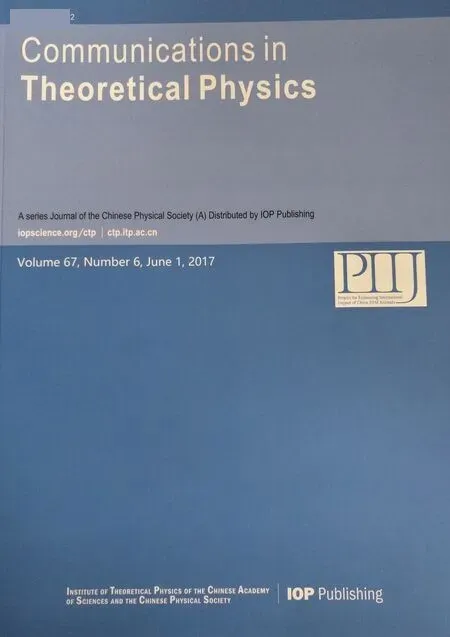 Communications in Theoretical Physics2017年6期
Communications in Theoretical Physics2017年6期
- Communications in Theoretical Physics的其它文章
- A Pair of Resonance Stripe Solitons and Lump Solutions to a Reduced(3+1)-Dimensional Nonlinear Evolution Equation∗
- New Patterns of the Two-Dimensional Rogue Waves:(2+1)-Dimensional Maccari System∗
- Coherent-State Approach for Majorana Representation∗
- Two-Body Local-Momentum Approximation of Spinless Particles Scattered by a(1+1)-D Woods–Saxon Barrier Potential
- Exhibition of Monogamy Relations between Entropic Non-contextuality Inequalities∗
- Quantum Coherence Quantifiers Based on R´enyi α-Relative Entropy∗
